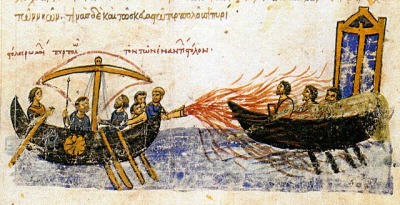For centuries, power in the Mediterranean had depended on naval might. At the end of the 6th century the Byzantine Empire dominated both the Mediterranean and the Black Seas with naval bases at Carthage, Alexandria, Acre and Constantinople. Yet the number of Byzantine warships remained few, because the Empire faced no serious maritime rivals until the Sassanian occupation of Egypt and Syria. Even more threatening were the subsequent Muslim conquests of these areas, as well as North Africa and, eventually, the Iberian peninsula.
In the Islamic forces’ first major naval operation in the Mediterranean, they temporarily occupied the island of Cyprus after having driven off a Byzantine fleet near Alexandria in 652 – their first naval victory. Then, in 655, the Islamic fleet won a convincing victory over the Byzantine navy off the south-western coast of what is now Turkey. For nigh on a thousand years Greeks and then Romans had dominated the Mediterranean Sea. Now, in the first major Mediterranean sea battle for centuries, an Arab fleet had successfully challenged the Byzantines in their home waters.
Surprisingly, given the relative inexperience of the Muslim fleet, this battle saw the Byzantines defeated both at sea and in a skirmish on shore at the same time. This clash in 655 near Cape Chelidonia, off the Lycian coast, came to be known as the ‘Battle of the Masts’ because the Muslims had landed to cut tall trees for the masts and yards of their new fleets, based in Egypt and Syria. A lack of suitable large timber would in fact hamper Muslim naval development throughout the medieval period, though it did encourage technological innovation in Islamic naval architecture. During this encounter the Byzantine ships seem either to have been moored in close formation or to have been tied together. As a result the Muslims were able to win because of their superior boarding and close-combat tactics.
The possible importance of the Sassanian influence on naval developments in the Middle East has only recently been considered. During their brief occupation of much of the eastern Mediterranean littoral, they had extended as far as to occupy the Greek island of Rhodes, plus some Anatolian coastal towns, though they almost certainly used captured Syrian, Cilician, Egyptian or Greek ships to do so.
The subsequent Muslim conquest of many of the same regions brought the Arabs to the shores of the Mediterranean for the first time as a great military power and as the inheritors of Sassanian naval traditions. On the other hand the Arabian peoples had a far more active naval heritage than their initially cautious attitude to the Mediterranean might suggest. The pre-Islamic Yemenis and perhaps Omanis had, for example, been raiding Sassanian territory by sea since at least the 4th century AD while various other tribes from both the Gulf and Red Sea coastal regions of Arabia had similar maritime traditions. Here it is worth noting that, following the first wave of Islamic conquest, these same Yemeni and other coastal Arab tribes were often selected as garrison troops for strategic coastal bases including Alexandria.
In response to the challenge by new Arab-Islamic fleets, a more powerful Romano-Byzantine navy would emerge in the late 7th century. The ‘Battle of the Masts’ would not be the last naval encounter between these two rivals. Indeed, later Byzantine attempts to retake Egypt would convince Mu’awiya, the governor of Syria and subsequently the first Umayyad Caliph, of the need for a full Islamic navy in the Mediterranean.
The first such fleet was built in Egypt, where all qualified sailors were registered for naval service. Although many of these sailors were in fact Christians, the bulk were Yemeni in origin and Muslim in religion. The new fleet used Tyre and Acre as forward bases while Iranian and Iraqi shipwrights were brought from the Gulf to build and man the new or restored shipyards at Acre, Tyre and Beirut.
Other naval bases and fleets were established in newly conquered Tunisia and rather later in Libya; the resources of wood, iron and tar essential for medieval naval warfare all being available in North Africa. From the early 8th century onwards these new Islamic fleets undertook almost annual raids against Byzantine territory and islands in the western Mediterranean, mirroring the annual raids undertaken on land.
If there were any real differences between Byzantine and early Islamic warships, it would seem to have been in the increased height of the forecastle of the latter. This was soon being used to mount stone-throwing engines and to provide an advantage when boarding enemy vessels. The main fighting ship was a galley called a shini which, like the Byzantine galleys of the day, had between 140 and 180 oarsmen. It is also important to note that, with very few exceptions, the oarsmen in medieval galleys, be they Christian or Muslim, were paid volunteers not slaves.
By the mid-8th century such galleys defended themselves against the terrifying Byzantine incendiary weapon known as ‘Greek fire’ using various systems of water-soaked cotton, and would shortly use Greek fire themselves. However, the vessels of the rival naval powers remained remarkably similar, as there was an exchange of both technology and terminology between them.
The main difficulty facing any Islamic fleet continued to be a lack of timber. Indeed, this lack of resources may have stimulated the construction of larger ships, which were better able to defend themselves and were no longer regarded as expendable assets. Certainly, there was also a change from the hull- or skin-first method of construction to the more economical frame-first method, although this change would not be truly complete until the 11th century.
